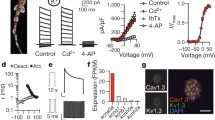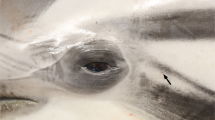Summary
In this study we examine the fine structure of mechanosensory hairs in the antennule of crayfish. The sensory hair is a stiff shaft with feather-like filaments. The hair's base is a large expansion of membrane which allows the hair shaft to deflect. The sensory transducing elements are located far from the hair, but are coupled mechanically with the hair shaft by a fine extracellular chorda. The sensory element is a type of scolopidium which consists of a scolopale cell and three sensory cells with a 9 + 0 type ciliary process.
This type of scolopidium is characteristic of the chordotonal organ that has no cuticular structure on the surface of the exoskeleton. In this crustacean hair receptor, the deflection of the cuticular hair is transmitted through the chorda to the scolopidium which is a tension-sensitive transducer. The present study reveals that the mechanosensory hair of decapod crustaceans is a chordotonal organ accompanied by a cuticular hair structure. We also discuss comparative aspects of cuticular and subcuticular chordotonal organs in arthropods.
Similar content being viewed by others
References
Ball EE, Cowan AN (1977) Ultrastructure of the antennal sensilla of Acetes (Crustacea, Decapoda, Natantia, Sergestidae). Phil Trans R Soc Lond B 277:429–457
Bromley AK, Dunn JA, Anderson M (1980) Ultrastructure of the antennal sensilla of aphids II. Trichoid, chordotonal and campaniform sensilla. Cell Tissue Res 205:493–511
Gaffai KP, Hansen K (1972) Mechanorezeptive Strukturen der antennalen Haarsensillen der Baumwollwanze Dysdercus intermedius Dist. Z Zellforsch 132:79–94
Gaffal KP, Tichy H, Theiß J, Seelinger G (1975) Structural polarities in mechanosensitive sensilla and their influence on stimulus transmission (Arthropoda). Zoomorphologie 82:79–103
Gnatzy W, Schmidt K (1971) Die Feinstruktur der Sinneshaare auf den Cerci von Gryllus bimaculatus Deg. (Saltatoria, Gryllidae). I. Faden- und Keulenhaare. Z Zellforsch 122:190–209
Guse GW (1978) Antennal sensilla of Neomysis integer (Leach). Protoplasma 95:145–161
Hensen V (1863) Studien über das Gehörorgan der Decapoden. Z wiss Zool 13:319–412
Horridge GA (1965) Arthropoda: Receptors other than eyes. In: Bullock TH, Horridge GA (eds) Structure and function in the nervous systems of invertebrates. Freeman, San Fransisco London, p 1038
Howse PE (1968) The fine structure and functional organization of chordotonal organs. Symp Zool Soc Lond 23:167–198
Keil T (1976) Sinnesorgane auf den Antennen von Lithobiusforficatus L. (Myriapoda, Chilopoda) I. Die Functionsmorphologie der “Sensilla trichodea”. Zoomorphologie 84:77–102
Kouyama N, Shimozawa T, Hisada M (1981) Transducing element of crustaean mechano-sensory hairs. Experientia 37:379–380
Lowe DA, Mill PJ, Knapp MF (1973) The fine structure of the PD proprioceptor of Cancer pagurus II. The position sensitive cells. Proc R Soc Lond B 184:199–205
Luft JH (1961) Improvements in epoxy resin embedding methods. J Biophysic Biochem Cytol 9:409–414
McIver SB (1975) Structure of cuticular mechanoreceptors of arthropods. Ann Rev Ent 20:381–397
Michel K (1974) Das Tympanalorgan von Gryllus bimaculatus Degeer (Saltatoria, Gryllidae). Z Morph Tiere 77:285–315
Mill PJ, Lowe DA (1973) The fine structure of the PD proprioceptor of Cancer pagurus I. The receptor strand and the movement sensitive cells. Proc R Soc Lond B 184:179–197
Moran DT, Rowley JC (1975a) The fine structure of the cockroach subgenual organ. Tissue Cell 7:91–105
Moran DT, Rowley JC, Varela FG (1975b) Ultrastructure of the grasshopper proximal femoral chordotonal organ. Cell Tissue Res 161:445–457
Moran DT, Varela FJ, Rowley JC (1977) Evidence for active role of cilia in sensory transduction. Proc Natl Acad Sci USA 74:793–797
Munn EA, Klepal W, Barnes H (1974) The fine structure and possible function of the sensory setae of the penis of Baianus balanoides (L). J Exp Mar Biol Ecol 14:89–98
Rowell CHF (1963) A general method for silvering invertebrate central nervous systems. Quart J micr Sci 104:81–87
Schmidt K (1969) Der Feinbau der stiftführenden Sinnesorgane im Pedicellus der Florfliege Chrysopa Leach (Chrysopidae, Planipennia). Z Zellforsch 99:357–388
Schmidt K (1970) Vergleichend morphologische Untersuchungen über den Feinbau der Ciliarstrukturen in den Scolopidien des Johnstonschen Organs der holometabolen Insekten. Verh Dtsch Zool Ges 64:88–92
Schmidt K (1973) Vergleichende morphologische Untersuchungen an Mechanorezeptoren der Insekten. Verh Dtsch Zool Ges 66:15–25
Schöne H, Steinbrecht RA (1968) Fine structure of statocyst receptor of Astacus fluviatilis. Nature 220:184–186
Strickler JR, Bal AK (1973) Setae of the first antennae of the copepod Cyclops scutifer (Sars): Their structure and importance. Proc Natl Acad Sci USA 70:2656–2659
Whitear M (1962) The fine structure of crustacean proprioceptors I. The chordotonal organs in the legs of the shore crab, (Carcinus maenas). Phil Trans R Soc Lond B 245:291–325
Wiersma CAG (1958) On the functional connections of single units in the central nervous system of crayfish, Procambarus clarki Girard. J Comp Neurol 110:421–471
Wiese K (1976) Mechanoreceptors for near-field water displacements in crayfish. J Neurophysiol 39:816–833
Young D (1970) The structure and function of a connective chordotonal organ in the cockroach leg. Phil Trans R Soc Lond B 256:401–428
Young D, Ball E (1974a) Structure and development of the auditory system in the prothoracic leg of the cricket Teleogryllus commodus (Walker). I. Adult structure. Z Zellforsch 147:293–312
Young D, Ball E (1974b) Structure and development of the tracheal organ in the mesothoracic leg of the cricket Teleogryllus commodus (Walker). Z Zellforsch 147:325–334
Author information
Authors and Affiliations
Rights and permissions
About this article
Cite this article
Kouyama, N., Shimozawa, T. The structure of a hair mechanoreceptor in the antennule of crayfish (Crustacea). Cell Tissue Res. 226, 565–578 (1982). https://doi.org/10.1007/BF00214785
Accepted:
Issue Date:
DOI: https://doi.org/10.1007/BF00214785




